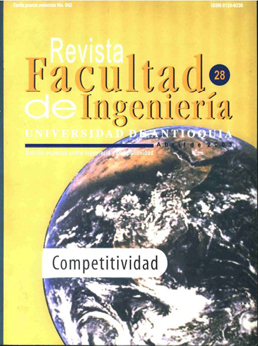Las normas ISO 9000 como medio para lograr una mayor competitividad en las empresas del Valle de aburrá
DOI:
https://doi.org/10.17533/udea.redin.326434Palabras clave:
Normas, competitividad, calidad, ISOResumen
El presente artículo muestra como las normas de calidad ISO 9000 son una buena herramienta que permite a las empresas, de Medellín y del Valle de Aburrá, mejorar su competitividad cuando se implantan con la debida responsabilidad y se mantienen en las organizaciones bajo criterios de mejoramiento continuado.Descargas
Citas
http://www.calidad.com.ar/iso9000-2000.html.
ISO/IEC Guía 2: 1996.
http://www.iso.org/iso/en/lSOOnline.openerpage.
http://www.crasa.com.mx/crasa _ centro.html.
Krajewski, Lee J. y Larry Ritzman. Administración de Operaciones. 5". ed., Pearson Educación. 2000. p. 7.
Zapata, Andrés y otros. Curso de Normas ISO. Semestre 1/2002. Facultad de Ingeniería. Universidad de Antioquia. Medellín. 2002. DOI: https://doi.org/10.17533/udea.redin.326354
Chase, Richard B. Administración de Producción y Operaciones, Manufactura y Servicios. 8ª. ed. McGrawHill. 2000. p. 143.
Arias, Alexánder y otros. Visión general sobre la encuesta realizada a las empresas del sector servicio en la implementación de las normas ISO, curso de Normas ISO semestre 1/2002, Facultad de Ingeniería. Universidad de Antioquia. Medellín. 2002.
Memorias del Foro ElA de la Calidad, en busca de una Antioquia competitiva.
Ross, Joel E., George H. David "A Survey of Productivity and Quality issues in Manufacturing: Toe State of Industrial Management", enero-febrero, 1991.
Triana, Silvio y otros. Visión general sobre la encuesta realizada a las empresas grandes del Valle de Aburrá, curso de Normas ISO semestre 112002. Facultad de Ingeniería. Universidad de Antioquia. Medellín. 2002.
Descargas
Publicado
Cómo citar
Número
Sección
Licencia
Los artículos disponibles en la Revista Facultad de Ingeniería, Universidad de Antioquia están bajo la licencia Creative Commons Attribution BY-NC-SA 4.0.
Eres libre de:
Compartir — copiar y redistribuir el material en cualquier medio o formato
Adaptar : remezclar, transformar y construir sobre el material.
Bajo los siguientes términos:
Reconocimiento : debe otorgar el crédito correspondiente , proporcionar un enlace a la licencia e indicar si se realizaron cambios . Puede hacerlo de cualquier manera razonable, pero no de ninguna manera que sugiera que el licenciante lo respalda a usted o su uso.
No comercial : no puede utilizar el material con fines comerciales .
Compartir igual : si remezcla, transforma o construye a partir del material, debe distribuir sus contribuciones bajo la misma licencia que el original.
El material publicado por la revista puede ser distribuido, copiado y exhibido por terceros si se dan los respectivos créditos a la revista, sin ningún costo. No se puede obtener ningún beneficio comercial y las obras derivadas tienen que estar bajo los mismos términos de licencia que el trabajo original.










 Twitter
Twitter